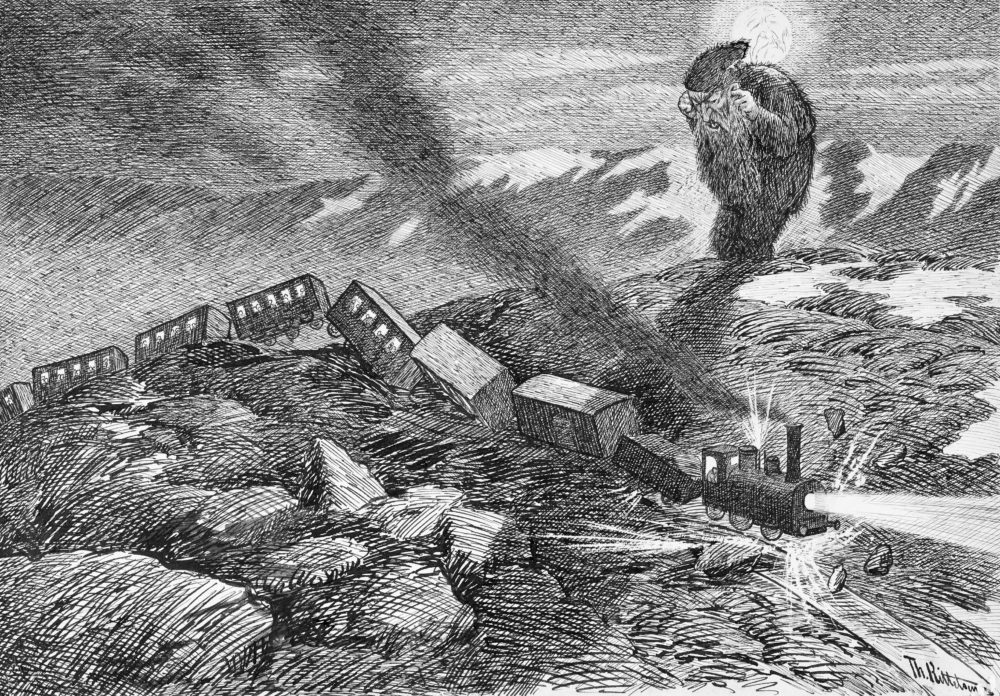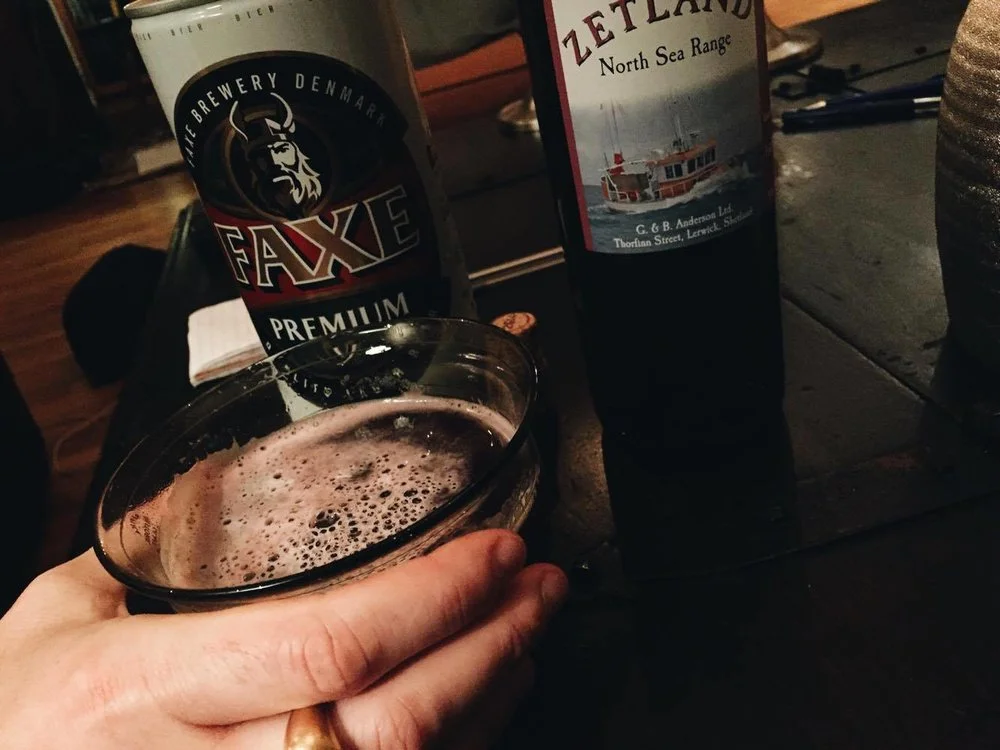Moltke Moe's "Rejuvenation Tonic" - An Invigorating Mulled Tobacco Beer That Will Absolutely Kill You
/Let’s start with a flippin’ disclaimer: I do not recommend that anybody follow the recipe stated in this article. Nicotine is hazardous and any unorthodox method of administration should be carried out with caution. I take no responsibility for any dim ideas that might arise from this article.
Now, is this a trip report or a review? I honestly don’t know. Nothing makes sense anymore. Beer and liquor and smokes are suddenly all the same. There is no separation, no up nor down. Today I question all my life’s decisions that led me down this path of sin and misery.
But first of all, let me explain: It was way back Brute Norse’s infancy, when I went by the name Tulen and ran myself off the bend doing Norse related Q&As, that my old friend Rudi Endresen challenged me to recreate a beverage described by the Norwegian folklorist Moltke Moe, the lesser known (but still brilliant) son of the legendary compiler of fairy tales Jørgen Moe, on an expedition to Bø in Telemark. A bizarre concoction consisting of beer, spirits, and tobacco, intended to grease the throats of his sources. The tale was recounted by Knut Liestøl in his biography of Moe the younger, and in Norwegian it goes like this:
Ein gong ville han få til et lag sjølv. Han hadde høyrt av gamlingane i Bø at i ungdomen sin hadde dei hatt så svær ein oppkveikingsdrykk. Det var øl og brennevin saman, som vart oppvermt og hatt litegrand tobakk i. Så kom Moe på at dersom han no laga ein slik drykk til dei og fekk dei saman, så ville minnet friskna og tungebandet losna, og han ville få høyra mykje gamalt som dei elles ikkje kom i hug. Ja, laget kom i stand, og drykken var der, og stemninga steig fort i taket. Men det vart ein fiasko, for gamlingane tolde ikkje retteleg den drykken dei hadde hadd slik glede av i ungdomen. Dei sovna om eit lite bel, og noko gamalt fekk han ikkje.
Now in English, my emphasis added:
One time he wanted to organize an assembly himself. He had heard from the old folks in Bø that in their youth, they used to have this great rejuvenation drink. This was beer and liquor together, which was heated with a small bit of tobacco added. Moe had this idea that if he could make such a drink for them and get them all together, then their memory would be refreshed and their tongues loosened, and he would hear lots of old things they otherwise failed to remember. Indeed, the assembly happened and the drink was there, and the mood grew quickly intense. But it was a fiasco, because the old people no longer tolerated as well the drink they had enjoyed so much in their youth. They fell asleep soon after, and nothing old was gained for him.
And so I set out to recreate this particular little crap nugget from the cozy outhouse of Norwegian folk culture. Screw all that wine after beer nonsense.
The Grim Reaper (or is it Kittelsen’s “Pesta”?) entertains Moltke Moe with fairytales, in Bø, Telemark. The scene of the crime.
A translation rarely flows well when it’s literal. The same principle applies to reconstructing Moltke Moe’s mnemonic elixir, as the specifics elude us. I haven’t got a clue whether he used local farmhouse beer or some commercial alternative, or from whence he sourced his liquor, so rather than giving in to speculation I decided it was best to opt for a solution based on somewhat common ingredients, for eased consumption and guzzability (?).
In the former incarnation of this recipe I used rolling tobacco, which was convenient. I believe I only used a pinch last time around — admittedly a path I should never have strayed from — but my concept of measurement when it comes to tobacco is shaky. I’m no smoking man and I don’t know a living soul on this side of the Atlantic, so I resorted to bum an American Spirit from a co-worker. As for the remaining ingredients I went for a malt-forward Belgian dubbel and a standard Norwegian aquavit. I threw the ingredients in a pot and heated them to right below boiling temperature, then transferred the concoction into a coffee press to separate the solids. In yonder past, tobaccer was a relatively expensive luxury. You seen the size of clay pipes and whatnot? People smoked a small pinch at a time. Had this moment of historical clarity come to me sooner, I would have severely cut down on the tobacco content. But this is a modernized recipe, and what is more modern than short-sighted, wholesale idiocy?
Drunk warm, it was immediately clear that liquor and beer alone would make for a tasty winter warmer, and slowly other effects began to manifest as well. It didn’t take long before I started feeling excited and spirited, courtesy of the double buzz of alcohol and the unfamiliar nicotine rush. Alert like a motherfucker! I listened to some devilish fiddle jigs and rocked back and forth as I punched the air. In my dipsomania they flashed before my mind’s eye; the infamous brawls of peasant dances past. It all made sense now. I felt like kicking hats off long sticks and brandishing knives, to do ill deeds, throw rocks in the ocean and strike bargains with the devil.
I hear you, brother
That all sounds cool and all, but it went downhill fast from there. This was the point of no return. I recall similar, albeit weaker effects at the time of the first reconstruction several years back, but this time I was flying way too close to the sun. I began to sweat profusely. One whole cig per tankard was obviously too much. My nicotine extraction method was too efficient for my own good.
My innards loosener from their place and began to wander my wretched body. For the sake of the article I’m pretending this all happened in the past, but this is happening at the time of writing. Or should I say times of writing, because I had to take multiple breaks to finish this short piece. First to pace around the room, but nausea forced me back on my ass. This is a nonlinear article. The sickness encroached upon me like a bridge troll, and I ended up vomiting multiple times before finally crawling to bed, where I took an hour long nap before I returned to finish this mess of a review. I found the half-full (!) tankard mocking me from the corner of the table, so I poured the fucker out. I’ll let you believe that parts of this very text was written with my left hand as my right hand kept the toilet seat from dunking my head into the bowl. Did I damn near assassinate myself for the sake of immersive anthropology? True to the original account this was a total fiasco, and now, several hours later, I still feel like shit.
So to sum things up: So basically Moltke Moe (1859-1913) was a Norwegian folklorist who once got a bunch of old folks so drunk they passed out by lacing their beer with liquor and tobacco. It was a disaster then, and it was a disaster now. Would I do it again? A nice mulled beer I would not mind, but leave the nicotine out of it.
Recipe: Moltke Moe’s “rejuvenation tonic“ à la Brute Norse aka. Scandinavian ayahuasca
0.33 l of dark Belgian abbey ale (8% alcohol)
4 cl of Norwegian aquavit (40% alcohol)
1 cigarette, but maybe just one third of this if you are sane
1. Unroll cigarette, mix all ingredients in a suitably sized pot.
2. Heat slowly on a stove top, do not boil.
3. Transfer concoction to a coffee press, or pour it through a tea strainer to filter out the tobacco.
4. Serve in a solid mug or tankard, then pour it straight down the drain. Or, if you are prone to self-harm, drink slowly while it’s still warm.
Pair with warm sheets in a well ventilated room, or some devilish Nordic jams.
Support Brute Norse on Patreon, by donating on Paypal, or by buying a maðrloving shirt from the Teespring store.
Related reading:
From Bog Myrtle to Hops: Ethnobotanical fragments from the history of Nordic beer brewing
Dance, Trance, and Devil Pacts: The Fiddler in Norwegian Folk Mysticism























































